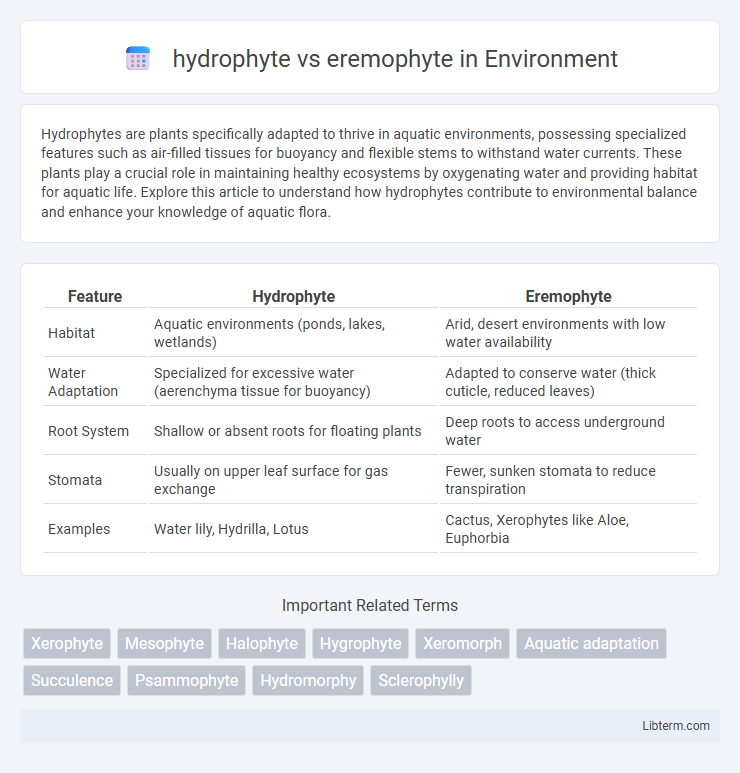Hydrophytes are plants specifically adapted to thrive in aquatic environments, possessing specialized features such as air-filled tissues for buoyancy and flexible stems to withstand water currents. These plants play a crucial role in maintaining healthy ecosystems by oxygenating water and providing habitat for aquatic life. Explore this article to understand how hydrophytes contribute to environmental balance and enhance your knowledge of aquatic flora.
Table of Comparison
| Feature | Hydrophyte | Eremophyte |
|---|---|---|
| Habitat | Aquatic environments (ponds, lakes, wetlands) | Arid, desert environments with low water availability |
| Water Adaptation | Specialized for excessive water (aerenchyma tissue for buoyancy) | Adapted to conserve water (thick cuticle, reduced leaves) |
| Root System | Shallow or absent roots for floating plants | Deep roots to access underground water |
| Stomata | Usually on upper leaf surface for gas exchange | Fewer, sunken stomata to reduce transpiration |
| Examples | Water lily, Hydrilla, Lotus | Cactus, Xerophytes like Aloe, Euphorbia |
Introduction to Hydrophytes and Eremophytes
Hydrophytes are plants adapted to grow in aquatic environments with abundant water, characterized by specialized structures like aerenchyma for buoyancy and oxygen transport. Eremophytes thrive in arid and desert conditions, displaying adaptations such as deep root systems, reduced leaf surface area, and water storage tissues to survive drought stress. Understanding these adaptations highlights the evolutionary strategies plants utilize to optimize water availability and retention in diverse ecosystems.
Defining Hydrophytes: Key Characteristics
Hydrophytes are plants adapted to grow in aquatic environments or water-saturated soils, characterized by specialized structures such as aerenchyma for buoyancy and thin cuticles to facilitate gas exchange. These plants exhibit traits like extensive root systems for anchorage in submerged conditions, and stomata often located on upper leaf surfaces to optimize photosynthesis above water. In contrast, eremophytes thrive in arid environments, demonstrating adaptations such as thick cuticles and reduced leaf areas to minimize water loss.
Understanding Eremophytes: Essential Features
Eremophytes are specialized plants adapted to survive in arid and desert environments, displaying key features such as deep root systems, reduced leaf surface area, and thick cuticles to minimize water loss. Unlike hydrophytes, which thrive in aquatic or waterlogged habitats with adaptations like aerenchyma tissue and floating leaves, eremophytes exhibit xerophytic traits including stomatal regulation and succulent tissues for water storage. Understanding these essential features highlights how eremophytes efficiently conserve water and endure prolonged drought conditions in contrast to hydrophytes.
Habitat Differences: Aquatic vs Arid Environments
Hydrophytes thrive in aquatic environments with abundant water, often found in ponds, lakes, and wetlands where their adaptations prevent waterlogging. Eremophytes are specialized for arid environments, such as deserts, with features that minimize water loss and maximize moisture absorption from scarce sources. These habitat differences drive distinct physiological and morphological traits essential for survival in aquatic versus dry, sandy soils.
Morphological Adaptations in Hydrophytes
Hydrophytes exhibit morphological adaptations such as thin, porous leaves with large air spaces (aerenchyma) to facilitate buoyancy and efficient gas exchange in aquatic environments. Their roots are generally reduced or absent, allowing better absorption of dissolved oxygen and nutrients directly from water. The presence of stomata primarily on upper leaf surfaces helps optimize transpiration and gas exchange in submerged or floating conditions.
Structural Adaptations in Eremophytes
Eremophytes exhibit specialized structural adaptations such as thick, waxy cuticles, reduced leaf surface area, and sunken stomata to minimize water loss in arid environments. Their extensive root systems often penetrate deep soil layers to access scarce water resources, while some develop succulent tissues to store moisture. These morphological traits enhance drought resistance, differentiating eremophytes from hydrophytes, which possess adaptations suited for aquatic habitats like aerenchyma and thin cuticles.
Physiological Strategies for Water Management
Hydrophytes employ physiological adaptations such as large aerenchyma for buoyancy and efficient gas exchange, thin cuticles to facilitate water absorption, and stomatal regulation to prevent excess water loss despite abundant availability. Eremophytes exhibit strategies including extensive root systems for deep water access, thick cuticles to minimize transpiration, and CAM photosynthesis enabling stomatal opening at night to reduce water loss in arid environments. Both plant types optimize water management by modulating cellular turgor, osmotic adjustments, and specialized tissue structures tailored to their moisture extremes.
Ecological Roles and Importance
Hydrophytes, adapted to aquatic environments, play a crucial role in maintaining water quality by oxygenating water and providing habitat for aquatic organisms. Eremophytes thrive in arid conditions, stabilizing soil and preventing desertification through their deep root systems and drought resistance. Both plant types contribute to ecosystem sustainability by supporting biodiversity and enhancing resilience to environmental stressors.
Examples of Hydrophyte and Eremophyte Species
Common hydrophyte species include water lilies (Nymphaea spp.), lotus (Nelumbo nucifera), and duckweed (Lemna minor), all adapted to aquatic environments. Eremophyte species such as cacti (Cactaceae family), date palms (Phoenix dactylifera), and creosote bush (Larrea tridentata) thrive in arid desert conditions with specialized drought-resistant features. These plants exemplify adaptations to extreme water availability, with hydrophytes exhibiting features like air-filled tissues and eremophytes showing deep root systems and water storage capabilities.
Comparative Summary: Hydrophytes vs Eremophytes
Hydrophytes are plants adapted to aquatic environments with features like aerenchyma tissue for buoyancy and thin cuticles to facilitate gas exchange, whereas eremophytes thrive in arid conditions with thick cuticles and deep root systems to minimize water loss. Hydrophytes generally exhibit broad, flat leaves to maximize photosynthesis under water, contrasting with the small, reduced leaves or spines of eremophytes that reduce transpiration. The physiological adaptations of hydrophytes enable survival in water-saturated soils, while eremophytes develop drought resistance mechanisms such as CAM photosynthesis to endure prolonged water scarcity.
hydrophyte Infographic

 libterm.com
libterm.com